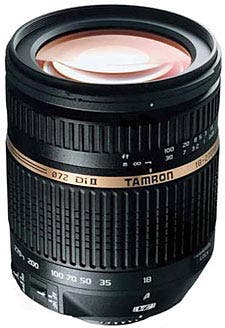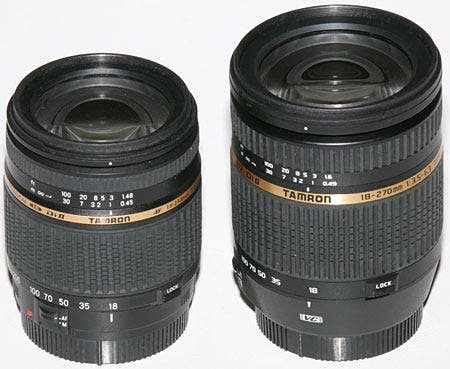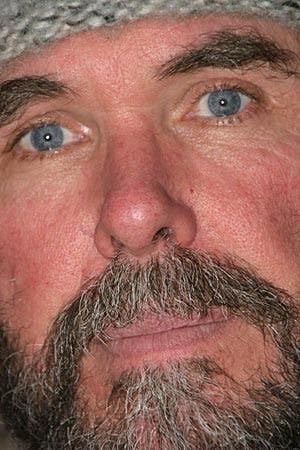Tamron 28-300mm F/35-63 Xr Di Vc Ld Ii Aspherical if Macro for Canon Review
Tamron updates its superzoom.
 Tamron is no stranger to long-range zooms, having introduced one of the first eighteen-200mm f/3.5-5.6 lenses for APS-C-format DSLRs several years ago. At the time, having a handy, lightweight lens providing a 35mm-equivalent range of 28-300mm (11.1X zoom ratio) along with macro focusing seemed pretty remarkable. The lens sold extremely well and other manufacturers, including photographic camera makers like Nikon and Catechism shortly followed suit with their own 18-200s, in some cases adding image stabilization.
Tamron is no stranger to long-range zooms, having introduced one of the first eighteen-200mm f/3.5-5.6 lenses for APS-C-format DSLRs several years ago. At the time, having a handy, lightweight lens providing a 35mm-equivalent range of 28-300mm (11.1X zoom ratio) along with macro focusing seemed pretty remarkable. The lens sold extremely well and other manufacturers, including photographic camera makers like Nikon and Catechism shortly followed suit with their own 18-200s, in some cases adding image stabilization.
Last yr, Tamron upped the ante with the very successful eighteen-250mm f/3.5-six.iii that wasn't much bigger or heavier than an 18-200mm but provided a useful chip of extra attain at the tele end. Considering its xiii.9X zoom ratio and approximately 390mm-equivalent maximum focal length, its functioning is outstanding, especially with respect to flare control and resolution at the longest focal lengths, areas where long tele zooms of the past had a performance deficits.
At present Tamron has unleashed an fifty-fifty longer ultra-long-range zoom in Canon and Nikon mount with truly spectacular specs. Information technology'south an xviii-270mm f/3.5-half dozen.3 with built-in proprietary VC optical image stabilization. Just how good is this remarkable 15X zoom ratio, 28-419mm-equivalent ultra-zoom? I put it through its paces to find out.

Tamron 18-250mm lens, left, is but a little smaller than the new Tamron 18-270mm VC, right.
Tour of the lens

Test shots: 28mm

50mm

135mm

270mm
The new Tamron AF 18-270mm f/3.5-6.iii DiII VC LD Aspherical (IF) MACRO (quite a mouthful!) feels substantial, scrap it'due south not all that much larger or heavier than the Tamron eighteen-250. Weighing in at nineteen.iv ounces and measuring 3.8 inches long (at the 18mm setting) and 3.1 inches in diameter, it's four.half-dozen ounces heavier than the xviii-250mm, half an inch longer, and about 1/four-inch thicker—not bad for a lens providing 20mm in boosted focal length plus built-in vibration compensation (VC). The lens balances beautifully on mid-size DSLRs like the Canon 40D (our test camera) the new 50D, or comparable Nikons like the D90 and D300.
To clear up Tamron's alphabet soup, DiII denotes that information technology's a member of the 2d generation of digitally integrated lenses said to be optimized for DSLR cameras with APS-C-size sensors, LD stands for special depression-dispersion glass for improved aberration correction, and yous probably know that (IF) means internal focusing, which offers performance advantages and is a proficient affair to take on a zoom whose barrel already extends a bit over 3-1/2 inches in length when you zoom from 18mm to 270mm.
While a bit of extra reach can exist useful in, for case, wildlife photography, past far the near significant feature on this lens is vibration compensation, which Tamron calls VC. It'due south an original pattern developed by Tamron that employs a tri-axial arrangement that electromagnetically drives a vibration compensator lens that's supported on three steel ball bearings.
Because the compensator lens is free to move in whatever direction in its low-friction mount, the system provides theoretical advantages that include enhanced compensation for oblique too every bit horizontal and vertical shake and enhanced follow-up operation resulting in more stable viewfinder images. Since the mechanism is designed to allow parallel shifting of the compensator lens solely by means of electric command, the mechanical construction is too simpler and more robust, so the lens tin exist kept as pocket-size and light as possible. This is borne out by the fact that the size and weight are only marginally greater than the Tamron 18-250 without VC.
Earlier we put this impressive zoom through its paces, let's take a closer await at information technology. Like most recent Tamron zooms, its metallic lens mount and black polycarbonate barrel are very well finished, the latter in a subtly textured pattern. The well-nigh 2-inch-wide textured rubberized zoom ring and iii/four-inch-wide focusing ring provide a good grip and both turn very smoothly and easily.
As with many AF lenses, there is too trivial damping on the focusing ring when you lot switch from AF to MF (manual focusing). Also, every bit yous zoom the lens from xviii-270mm, turning the zoom band requires extra effort as you motion it through the eye of the zoom range betwixt about 70 and 135mm. This isn't really roughness, but a lack of linear response in the multi-cam zooming mechanism required in a lens of this type and it's not all that noticeable when y'all're shooting.
Both the focal length and altitude scales are legible in black on white and there's a cool looking golden lens identification ring on the barrel, but backside the distance scales. There's also a locking tab on the zoom ring that tin can lock the lens in its shortest position when it's set to 18mm only it actually isn't needed because "zoom creep" is not a problem. Finally in that location's an on-off switch for the VC system on the side of the barrel—it's recommended that yous plough it off when using a tripod.
In the field
Shooting with the 18-270 VC is a very pleasant feel—information technology's the closest affair ever to the mythical "universal lens" for DSLRs. It makes you wonder how nosotros managed to become along without a 15X zoom that goes reasonably wide and very long. Because the 2-stage telescoping polycarbonate barrel is so light and the bulk of the heaviest components are located at the rear, it maintains its excellent balance fifty-fifty when fully extended.
It's at those long-end focal lengths that the VC organisation actually makes a big difference. It was easy to achieve critically sharp handheld images when shooting in the 250-270mm range at i/sixty sec. I averaged 9 out of 10 sharp images at 1/30 sec—an impressive operation. I even managed to burn down off a goodly percentage of critically precipitous pictures of stationary subjects at 1/15 sec, validating Tamron'southward claim of up to 4 stops of vibration compensation.
As yous would expect, paradigm stabilization performance at shorter focal lengths is equally proficient as or better than that, and we were able to capture surprisingly precipitous pictures in the macro range, downwardly to xix.3 inches or ane:three.5 magnification at the 270mm setting. It took u.s.a. two tries to get an acceptably sharp portrait at most 20 inches at 270mm and one/4 sec (!), and you may rest assured nosotros never could take done it without turning on the VC.
Apparently the system is just as effective for shooting action pictures, just if the shutter speed you utilise is as well tiresome you'll go motility blur even when the images are technically shake-issue free. Oh yep, the viewfinder image was commendably stable and shake-free as well.
Although there is a slight darkening of the viewfinder when you zoom to the longest focal lengths and the effective aperture is reduced to f/5.vi-6.3 this did not pose any problems in composing the shot or manually focusing in outdoor or average indoor shooting situations. The f/six.3 minimum discontinuity at 270mm as well did not preclude the Canon D40 from auto-focusing swiftly even in dim light, and with the fantabulous imaging performance of today'south meridian DSLRs at ISO 400, 800 and fifty-fifty 1600 and across, having a relatively modest aperture at the longest focal lengths will seldom cramp your shooting style. In terms of sound output, the AF mechanism is as about average—not as placidity as some ultrasonic motor systems only hardly noisy plenty to exist objectionable.
A lens with flair…simply not much flare
The Tamron 18-270mm VR comes with a flower-shaped lens hood that bayonets onto the forepart lens band, positioning its longer lite-blocking flanges at the superlative and lesser of the lens. Information technology seems to do a reasonably good job in preventing sunlight from above from striking the forepart lens surface, but information technology's less constructive in blocking sidelight, and the hood is not designed to exist turned xc degrees to position the longer flanges on the sides—if you try this it will fall off.
Fortunately, the lens is remarkably gratuitous of flare for a an 18-chemical element, 13-grouping ultra-zoom and saturated flare-free images are the rule, fifty-fifty when shooting confronting the light—a performance similar to what nosotros experienced with the Tamron 18-250mm. Evidently the multi-blanket department at Tamron has some pretty good engineers and uses some pretty sophisticated manufacturing techniques, though the optical design plays a part in this as well.
In the not-too-distant by, extended range zooms were non noted for their stellar functioning, especially in terms of linear baloney, flare control, and resolution at the longest focal lengths. Things accept improved considerably in all these areas over the years and today consumers take a pretty wide choice of the high quality long-range zoom lenses at relatively moderate prices. Nonetheless, in terms of sheer range, and real-globe operation, the remarkable 15X Tamron 18-270mm VC MACRO is not only the world'southward longest-range interchangeable zoom lens for DSLRs, it'south likewise one of the best.
Specifications
Adorama price: $599.95
Focal Length: 18 – 270mm
Maximum Aperture: f/3.five – six.3
Bending of View
(Equivalent to APS-C size) Diagonal: 75°33′ – 5°55′
Horizontal: 65°36′ – iv°55′
Vertical: 46°21′ – 3°10′
Lens Construction: 18 elements xiii groups
Minimum Focus Distance: 0.49m (19.3")
Max. Mag. Ratio: 1:3.5 (at 270mm, Min. Focus Altitude)
Overall Length: 101.0mm (3.9″)*
Maximum Diameter: 79.6mm (three.1″)
Filter Size: 72mm
Weight: 550g (nineteen.5oz.)*
Diaphragm Blades: 7
Minimum Aperture: f / 22 ~ F / forty (18mm ~ 270mm)
Standard Accompaniment: Blossom-shaped hood
Compatible Mounts: Canon, Nikon
* Values given are for Nikon-mount cameras.
Source: https://www.adorama.com/alc/review-tamron-af-18-270mm-f-35-63-diii-vc-lens/
0 Response to "Tamron 28-300mm F/35-63 Xr Di Vc Ld Ii Aspherical if Macro for Canon Review"
Post a Comment